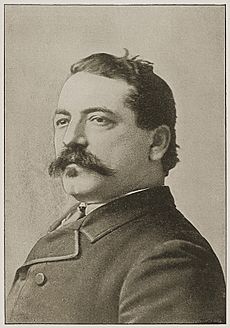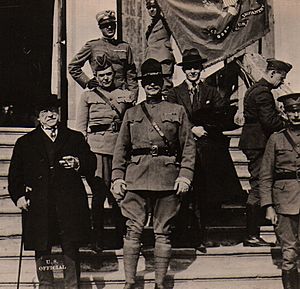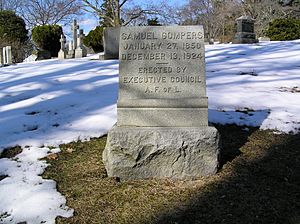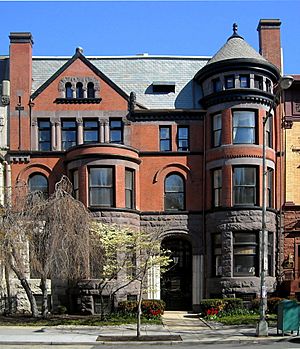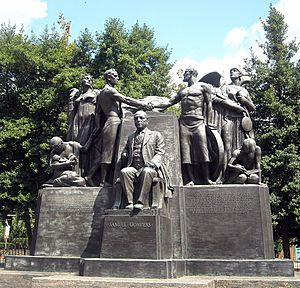Samuel Gompers facts for kids
Quick facts for kids
Samuel Gompers
|
|
|---|---|
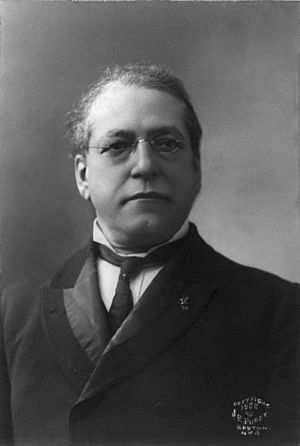
Gompers c. 1902
|
|
| Born |
Samuel Gumpertz
January 27, 1850 Spitalfields, London, England
|
| Died | December 13, 1924 (aged 74) San Antonio, Texas, U.S.
|
| Resting place | Sleepy Hollow Cemetery |
| Occupation | Labor leader, cigar maker |
| Spouse(s) |
|
| Signature | |
Samuel Gompers (born Gumpertz; January 27, 1850 – December 13, 1924) was a very important leader in American labor history. He was born in Britain but became an American citizen. Gompers was a cigar maker who helped create and lead the American Federation of Labor (AFL).
He was the president of the AFL for most of his life, from 1886 to 1894, and then from 1895 until he died in 1924. Gompers worked hard to bring different craft unions together. He wanted them to work in harmony and avoid arguments. His main goals were to get shorter work hours and higher wages for workers. He believed these were the first steps to making workers' lives better.
Gompers encouraged AFL unions to get involved in politics. He told them to "elect their friends" and "defeat their enemies." He usually supported the Democratic Party. He also strongly opposed immigration from China. During World War I, Gompers and the AFL supported the war effort. They tried to prevent strikes and boost morale. At the same time, they worked to increase wages and union membership. He was against groups that opposed the war, like the Industrial Workers of the World (IWW).
Contents
Early Life and Education
Samuel Gumpertz was born on January 27, 1850. His family lived in Spitalfields, a working-class area in London, England. His family was Jewish and originally from Amsterdam. Samuel's father, Solomon Gumpertz, was also a cigar maker.
When Samuel was six, he went to the Jewish Free School. He only studied there for a short time. Just after his tenth birthday, Samuel started working. He became an apprentice cigar maker to help his family earn money. Even while working, Gompers continued to study at night school. He learned Hebrew and studied the Talmud. He later said this was like studying law.
Becoming a Young Worker
In 1863, Gompers' family moved to the United States. They were very poor. They settled in the Lower East Side of Manhattan, New York City. For about a year and a half, Samuel helped his father make cigars at home.
In his free time, Samuel started a debate club with his friends. This helped him learn how to speak in public and run meetings. Through the club, he met other young men, including Peter J. McGuire. McGuire later became very important in the AFL.
In 1864, when he was 14, Gompers joined the Cigar Makers Local Union No. 15. This was the English-speaking union for cigar makers in New York City. The day after his seventeenth birthday, he married Sophia Julian. She was 16 and also worked as a cigar maker. They had many children, but only six lived past infancy.
In 1873, Gompers started working at David Hirsch & Company. This was a "high-class shop" for skilled cigar makers. Gompers said this move was "one of the most important changes in my life." At Hirsch's, he met German cigar makers who had deeper ideas. He learned German and was influenced by their thoughts. He especially admired Karl Laurrell. Laurrell taught Gompers to focus on strong trade unions. He believed unions were more important than socialist political movements.
Gompers felt that the socialist movement focused too much on politics. He warned that when people got excited about socialism, they often "lost interest in their union."
Leading the Cigar Makers' Union
In 1875, Gompers was elected president of Cigar Makers' International Union Local 144. Like many unions, the Cigar Makers' Union almost fell apart during a financial crisis from 1873 to 1877. Many people lost their jobs. Workers were willing to work for very low wages, which hurt union efforts to get better pay and shorter hours.
Gompers and his friend Adolph Strasser used Local 144 to rebuild the union. They made union dues higher. They also started programs to give money to members who were out of work, sick, or whose families needed help after a death.
Gompers told workers they needed to organize because wages were always being cut. He believed that business owners only cared about profits. He said, "the time has come when we must assert our rights as workingmen." He felt that individual workers were powerless, but united, they could be strong. He wanted to raise the pay of the lowest-paid worker to the highest standard. He hoped this would help every cigar maker have a life "worthy of human beings."
He became second vice president of the Cigar Makers' International Union in 1886. In 1896, he became first vice president. Even while leading the AFL, Gompers remained first vice president of the Cigar Makers' Union until he died in 1924.
Leading the AFL
Gompers helped start the Federation of Organized Trades and Labor Unions in 1881. This was a group of unions that thought alike. In 1886, it became the American Federation of Labor (AFL), with Gompers as its president. He led the AFL until his death, except for one year in 1895. In 1894, he also became the editor of the AFL's magazine, The American Federationist.
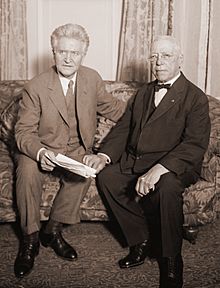
Under Gompers' leadership, the AFL grew stronger. It took over the role previously held by the Knights of Labor, which almost disappeared by 1900. Gompers faced legal challenges. In 1911, he was almost jailed for publishing a list of companies to boycott. But in 1914, the Supreme Court overturned his sentence.
Views on Immigration and Global Issues
Gompers had connections with Cuban cigar workers in the U.S. He supported American involvement in Cuba, which led to the war with Spain in 1898. However, after the war, he joined a group called the American Anti-Imperialist League. This group opposed President William McKinley's plan to take over the Philippines. Some historians say his opposition was partly because he worried about low-paid workers from other countries affecting American jobs.
By the 1890s, Gompers wanted to create an international group of labor unions. He started by expanding the AFL into Canada. He helped the Canadian Trades and Labour Congress with money and organizers. By 1902, the AFL was the main union movement in Canada.
Gompers, like many labor leaders, was against unlimited immigration from Europe. He feared it could lower wages for American union workers. He strongly opposed all immigration from Asia. He believed it lowered wages and that Asian cultures could not easily fit into American society. Gompers was proud that the AFL was the first national organization to demand the exclusion of Chinese workers.
He and the AFL strongly supported the Chinese Exclusion Act of 1882. This law banned Chinese immigration. In 1901, the AFL published a pamphlet called "Some reasons for Chinese exclusion. Meat vs. Rice. American Manhood against Asiatic Coolieism. Which shall survive?" The AFL played a big part in passing immigration restriction laws from the 1890s to the 1920s. These included the 1921 Emergency Quota Act and the Immigration Act of 1924.
During World War I, Gompers strongly supported the war effort. President Woodrow Wilson appointed him to the Council of National Defense. There, Gompers led the Labor Advisory Board. He also became president of the American Alliance for Labor and Democracy. This group worked to stop anti-war messages among workers. In 1919, he went to the Paris Peace Conference as an advisor on labor issues. He led a group that recommended a workers' rights charter. These ideas were included in the Treaty of Versailles.
After the War
After the war, Gompers also led the U.S. labor delegates. This was at the first meeting of the International Federation of Trade Unions in Amsterdam in 1919. Even though he supported the war, he later supported freeing political prisoners. These were people jailed under wartime laws. He worked with Lucy Robins Lang on this effort, and they became friends.
Gompers' Ideas and Beliefs
During a tough economic time in the early 1890s, many workers were upset. In Chicago in 1893, the mayor warned that jobless people might riot. In August 1893, Gompers spoke to 25,000 unemployed workers. He criticized those who controlled wealth and industry. He asked why money was stored in banks while workers were homeless. He said that cutting workers' wages hurt everyone. When workers earn less, they buy less, which harms the whole economy.
Gompers started his career with some socialist ideas. But he slowly became more conservative in how he approached labor relations. He began to believe that unions could work with capitalism. He focused on getting economic benefits for workers. These included higher wages, shorter hours, and safe working conditions. He wanted workers to have a good home, food, clothing, and enough money to educate their children. He thought organizing unions was the best way to achieve these goals. He also encouraged union members to vote for politicians who supported their economic interests.
Gompers' focus on working with businesses was too conservative for some more radical leaders. These included Ed Boyce and Bill Haywood of the Western Federation of Miners (WFM). In 1905, Haywood and the WFM helped start the Industrial Workers of the World (IWW). Members of the IWW were called Wobblies. Their goal was to organize all workers and eventually replace capitalism. However, when the government treated WFM leaders unfairly, Gompers did offer them help.
Gompers and the AFL strongly fought against the IWW. He saw them as a group that caused problems and tried to destroy capitalism instead of helping workers. He even worked with the government when IWW leaders were arrested for opposing World War I. He said the IWW was like the Bolsheviki in Russia, and he pointed out what they had done to workers there.
Gompers also led the group within the AFL that was against socialism. He argued that socialists believed workers and businesses could never get along. He thought socialists wanted to use unions to push their political ideas. By 1920, Gompers had mostly reduced the influence of socialists in unions.
Freemasonry
Gompers was a prominent Freemason. He reached a high level in the Scottish Rite in 1906. In 1920, he wrote that Freemasonry helped protect freedom of thought and expression in many countries.
Death and Legacy
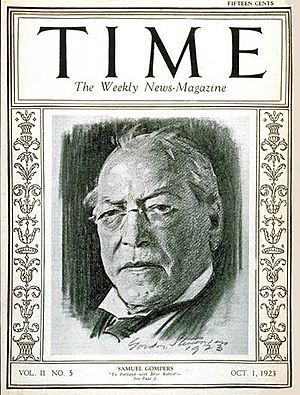
Gompers' health began to decline in early 1923. He had a serious case of influenza and then bronchitis. By June 1924, Gompers, who also had diabetes, could no longer walk without help. He was hospitalized again with congestive heart failure and uremia.
He collapsed in Mexico City on December 6, 1924, while at a meeting. His condition was very serious. Gompers wanted to die in the United States. He was put on a special train heading to the border. He died in San Antonio, Texas. Gompers was buried at the Sleepy Hollow Cemetery in Sleepy Hollow, New York. He is buried near Andrew Carnegie, another important figure from that time.
Gompers inspired many future labor leaders. George Meany praised Gompers for creating a unique American style of unionism. Reuben G. Soderstrom, a long-time labor leader in Illinois, said meeting Gompers in 1923 was very important for him. Gompers told Soderstrom, "Young man, you know you can climb the highest mountain if you've got the patience to do it one step at a time." Soderstrom never forgot those words.
Gompers' ideas led to the way unions and businesses negotiate today. This is called collective bargaining. AFL unions were important in industrial cities. They had central offices to coordinate different unions. Strikes often happened over wages and hours. But many strikes were also about making sure union workers were used for specific jobs. For example, plumbers might strike to ensure only union plumbers worked on big construction projects.
There are statues honoring Samuel Gompers in several American cities. A bronze monument is in Gompers Square in Washington, D.C. In Chicago, a life-size statue of Gompers was unveiled in Gompers Park in 2007. This was the first statue of a labor leader in Chicago. Local unions helped build it. A U.S. Navy ship, the USS Samuel Gompers, was named after him. The Samuel Gompers Houses are public housing in New York. Several schools are also named after him in cities like Philadelphia, Madison, Wisconsin, San Diego, Phoenix, Arizona, and The Bronx, New York.
On January 27, 1950, the 100th anniversary of his birth, the U.S. Post Office issued a 3¢ postage stamp with his picture. Gompers enjoyed visiting the National Cathedral, which has a stained glass window honoring him.
|
Works
- Seventy Years of Life and Labor: An Autobiography. In two volumes. New York: E.P. Dutton and Co., 1925. vol 2 online; vol1-2 online
- Samuel Gompers Papers. Stuart Bruce Kaufman, Peter J. Albert, and Grace Palladino (eds.) In twelve volumes. Urbana: University of Illinois Press, 1989–2010.
Other books and pamphlets
- Address of Samuel Gompers, Before the Arbitration Conference, Held at Chicago, Ill. Dec. 17, 1900, Under the Auspices of the National Civic Federation. Washington, D.C.: American Federation of Labor, 1901.
- Gompers, Samuel; Gutstadt, Herman (1902). Meat vs. rice; American manhhod against Asiatic coolieism, which shall survive?. American Federation of Labor printed as Senate document 137 (1902); reprinted with intro. and appendices by Asiatic Exclusion League, 1908. https://catalog.hathitrust.org/Record/002701816.
- Organized Labor: Its Struggles, Its Enemies and Fool Friends. Washington, D.C.: American Federation of Labor, n.d. [1904].
- Essence of Labor's Contention on the Injunction Abuse. Washington, D.C.: American Federation of Labor, 1908.
- Speech Delivered October 13, 1908, at Dayton, Ohio. Denver: Carson-Harper, n.d. [1908].
- Justice Wright's Denial of Free Speech and Free Press. Washington, D.C.: American Federation of Labor, 1909.
- Labor in Europe and America: Personal Observations from an American Viewpoint of Life and Conditions of Working Men in Great Britain, France, Holland, Germany, Italy, ... [etc.]. New York: Harper Brothers, 1910.
- The McNamara Case; Also, an Appeal for Funds to Secure a Fair and Impartial Trial. n.c. [Washington, D.C.]: McNamara Ways and Means Committee, n.d. [1911].
- Investigation of Taylor System of Shop Management: Hearings before... Washington, D.C.: U.S. Government Printing Office, 1911.
- The American Labor Movement: Its Makeup, Achievements and Aspirations. Washington, D.C.: American Federation of Labor, n.d. [1914].
- The Attitude of the American Federation of Labor toward Industrial Education. New York: C.S. Nathan, n.d. [1914].
- The Essence of the Clayton Law. Washington, D.C.: American Federation of Labor, n.d. [1914].
- The Double Edge of Labor's Sword: Discussion and Testimony on socialism and Trade-Unionism before the Commission on Industrial Relations. With Morris Hillquit and Max S. Hayes. Chicago: Socialist Party National Office, 1914.
- Labor and Antitrust Legislation: The Facts, Theory and Argument: A Brief and Appeal. Washington, D.C.: American Federation of Labor, 1914.
- The Workers and the Eight-Hour Workday; And, the Shorter Workday: Its Philosophy. Washington, D.C.: American Federation of Labor, n.d. [1915].
- Preparedness for National Defense: An Address Delivered before the Sixteenth Annual Meeting of the National Civic Federation on January 18, 1916, at Washington... Washington, D.C.: U.S. Government Printing Office, 1916.
- America's Fight for the Preservation of Democracy: An Address Delivered by Samuel Gompers at Minneapolis, Minn.: And the Declaration of Principles. n.c. [Washington, D.C.]: American Alliance for Labor and Democracy, 1917.
- Address by Samuel Gompers, President of the American Federation of Labor: Under the Auspices of the National Security League at Chicago, September 14, 1917. New York: National Security League, 1917.
- Should a Political Labor Party be Formed? An address by Samuel Gompers... to a labor conference held at New York city, December 9, 1918. Washington, D.C.: American Federation of Labor, 1918.
- Labour and the War: Speeches Delivered in the Canadian House of Commons, April 26, 1918, and Before the Canadian Club, Ottawa, April 27, 1918. Ottawa: [government publication], 1918.
- American Labor and the War. New York: G. H. Doran, 1919.
- Labor and the Common Welfare. New York: E. P. Dutton and Co., 1919.
- Labor and the Employer. New York: E. P. Dutton and Co., 1920.
- Collective Bargaining: Labor's Proposal to Insure Greater Industrial Peace: With Questions and Answers Explaining the Principle. Washington, D.C.: American Federation of Labor, 1920.
- Debate between Samuel Gompers and Henry J. Allen at Carnegie Hall, New York, May 28, 1920. With Harry Justin Allen. New York: E. P. Dutton and Co., 1920.
- [Washington, D.C.: American Federation of Labor, The Eight-Hour Workday: Its Inauguration, Enforcement, and Influences]. Washington, D.C.: American Federation of Labor, n.d. [1920].
- Labor's Protest against a Rampant Tragedy. Washington, D.C.: American Federation of Labor, 1920.
- Samuel Gompers on the Kansas Court of Industrial Relations Law: "Laws to make strikes unlawful will not prevent them." Washington, D.C.: American Federation of Labor, 1920.
- Letters to a Bishop: Correspondence between Samuel Gompers, President of the American Federation of Labor, and Bishop William A. Quayle, of the Methodist Episcopal Church. Washington, D.C.: American Federation of Labor, 1920.
- The Union Shop and Its Antithesis. Washington, D.C.: American Federation of Labor, 1920.
- The Truth about Soviet Russia and Bolshevism. Washington, D.C.: American Federation of Labor, n.d. [1920].
- Out of Their Own Mouths: A Revelation and an Indictment of Sovietism. With William English Walling. New York: E. P. Dutton and Co., 1921.
- The Fundamental Issues: Present Industrial Controversies an Expression of Vital Conflict between Industry and Finance. New York: New York Times, 1922.
- Correspondence between Mr. Newton D. Baker, President of the Cleveland Chamber of Commerce and Mr. Samuel Gompers, President of the American Federation of Labor. With Newton D. Baker. Washington, D.C.: American Federation of Labor, 1923.
- Address of Samuel Gompers, President of the American Federation of Labor: Before the Convention of the United Hatters of North America, New York City, April 16, 1923. Washington, D.C.: American Federation of Labor, n.d. [1923].
Articles
- "The Limitations of Conciliation and Arbitration", Annals of the American Academy of Political and Social Science, vol. 20 (July 1902), pp. 29–34. in JSTOR
- "Organized Labor's Attitude toward Child Labor", Annals of the American Academy of Political and Social Science, vol. 27 (March 1906), pp. 79–83. in JSTOR
- "Attitude of Labor towards Government Regulation of Industry", Annals of the American Academy of Political and Social Science, vol. 32 (July 1908), pp. 75–81. in JSTOR
- "Free Speech and the Injunction Order", Annals of the American Academy of Political and Social Science, vol. 36, no. 2 (September 1910), pp. 1–10. in JSTOR
- "European War Influences upon American Industry and Labor", Annals of the American Academy of Political and Social Science, vol. 61, (September 1915), pp. 4–10. in JSTOR
- "Labor Standards after the War", Annals of the American Academy of Political and Social Science, vol. 81 (January 1919), pp. 182–186. in JSTOR
- "The Development and Accessibility of Production Records Essential to Intelligent and Just Determination of Wage-Rates", Annals of the American Academy of Political and Social Science, vol. 100 (March 1922), pp. 54–55. in JSTOR
Primary sources
- Gompers, Samuel. Seventy Years of Life and Labor (1925, 1985 reprint); online
- Gompers, Samuel. The Samuel Gompers Papers edited by Stuart B. Kaufman, Peter J. Albert, and Grace Palladino. (University of Illinois Press, 1986–2013). The definitive edition of all important letters to and from Gompers. Published in 12 volumes; index in vol 13. partly online. Also note The index is online
See also
 In Spanish: Samuel Gompers para niños
In Spanish: Samuel Gompers para niños


